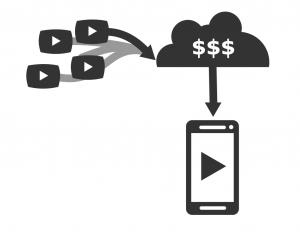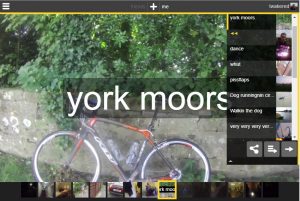Video has a lot of legacy components that need re-examining. Video used to be a hardware things, with tape and discs. Now it’s software; we all watch video on computers, but many of the old conventions are still with us. Even worse, the web was built for text (hTtp), and has bought it’s own conventions with it.
While trying to build a video platform, Strobee came up against many of these conventions, some of them helpful, others a hindrance. I’ve been collecting a list of them here:
- Why is every video the same every time, when our Facebook page is different every time we return to it? One of Strobee’s design challenges has been allowing this, as well as allowing visitors to revisit and link to videos they’ve seen before.
- Why do we always have to scroll down to see more video on Instagram or Vine? We are used to our web-browsers working as electronic-book-reading-machines. To accommodate this, the current web-video idiom is magical moving pictures on each page of the video book. Video is video, and should be fullscreen. The interface should be built around this ideal.
- Square videos are a fad, the world is starting to get over them. Our monitors, cinema, phones, and cameras seems to have settled on 16:9.
- Why does every video player need a play and pause button? They are legacy interfaces left over from hardware devices with actual buttons. There is no cost or side effect of not pausing a video. GIFs are a great example showing that we don’t need these controls any more.
- Long form video is a different media than social video. It has different conventions, constraints, and ways of viewing. My parents make appointments with TV – they’ve got to get home on time to watch 60 minutes of Inspector Morse at 9pm. To justify this kind of effort, video has to be 10s of minutes long, and once you’ve gone to all that effort, and watched something for 10 minutes, you’re trapped into to staying and watch the other 50 minutes.
- Strobee attempts to bridge the gap between long form and short form (micro-video) video – our video can be viewed in small sections, but also keeps playing endlessly, letting people who want to watch for 10s of minutes.
- Video navigation is a hard problem. It was very simple with cable TV: just pick a channel. Today we have many more variables possible (user, video clips, position in those clips, order of those clips, etc…). We experimented a bit, and just now Strobee has a fine-grain history (the clip gallery) along the bottom of the screen, and a course-grain explorer (the story navigator) up the right hand side of the screen.
- We should share video effortlessly and without thinking – in the same way we Instagram or tweet. We shouldn’t be worried that the video isn’t interesting to others or that the quality is lower than what we see on TV. We want to share our experiences using video with the click of a single button. Strobee is built to encourage this casual sharing. Clips are short, but what they lack in quality, they make up for that by both variety, and the interface’s ability to skip and explore.
- As with photos, some video clips are one-offs, but sometimes sequences of them tell a bigger story. Albums of photos can be more interesting than individual clips. When you look a photo album, you have to do the mental work to reconstruct the event – there’s no reason this shouldn’t work in video; there’s no reason, given the right format, why this shouldn’t be the case for video. Generating a perfect narrative (as we see in cinema), requires exact planning to capture every event – a totally different philosophy to the photo album.
- Unwatched video is a massive opportunity! Today, some of us have lots of video, in the future all of us will have lots of video. People with action-cameras (GoPros), are notorious for recording footage they never watch or share. They return from holiday with full memory cards, few have the patience to watch it all, fewer share any, and fewer still take the time to create a video that others would actually want to watch. It should be easy to share bulk footage like this, Strobee makes it a little easier, but there’s a long way to go…




